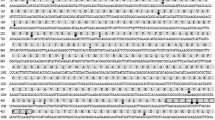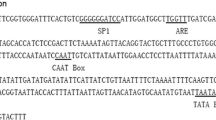Abstract
Heat shock protein 90 (HSP90) is a highly conserved molecular chaperone that plays key roles in the folding, maintenance of structural integrity, and regulation of a subset of cytosolic proteins. In this study, the cDNA of Haematococcus pluvialis HSP90 (designated HpHSP90) was cloned by the combination of homology cloning and rapid amplification of cDNA ends approaches. The full-length cDNA of HpHSP90 was of 2,606 bp, including an open reading frame of 2,109 bp encoding a polypeptide of 702 amino acids with predicted molecular weight of 80.14 kDa and theoretical isoelectric point of 5.07. BLAST analysis revealed that HpHSP90 shared high similarity with other known HSP90s, and the five conserved amino acid blocks defined as HSP90 protein family signatures were also identified in HpHSP90, which indicated that HpHSP90 should be a cytosolic member of the HSP90 family. Under different stress conditions, messenger RNA (mRNA) expression levels of HpHSP90 were quantified by quantitative RT-PCR. To H. pluvialis kept at different temperatures for 1 h, maximum HpHSP90 expression was observed in the range 5 to 10°C and 35 to 40°C and the expression level of HpHSP90 at 40°C was the highest (threefold compared with that at 25°C). In H. pluvialis kept at 35°C for different times, the mRNA expression level of HpHSP90 reached a maximum level after 7 h and then dropped progressively. The results indicate that HpHSP90 responded to cold and heat stresses with a temperature-dependent expression pattern as well as exposure time effect and could be used as a molecular biomarker in adverse stress environment.







Similar content being viewed by others
References
Ali A, Krone PH, Pearson DS, Heikkila JJ (1996) Evaluation of stress-inducible hsp90 gene expression as a potential molecular biomarker in Xenopus laevis. Cell Stress Chaperones 1:62–69
Boussiba S (2000) Carotenogenesis in the green alga Haematococcus pluvialis: cellular physiology and stress response. Physiol Plant 108:111–117
Breitenbach J, Fernandez-Gonzalez B, Vioque A, Sandmann G (1998) A higher-plant type f-carotene desaturase in the cyanobacterium Synechocystic PCC6803. Plant Mol Biol 36:725–732
Buchner J (1999) Hsp90 Co. – a holding for folding. Trends Biochem Sci 24:136–141
Caplan AJ (1999) Hsp90’s secrets unfold: new insights from structural and functional studies. Trends Cell Biol 9:262–268
Cara JB, Aluru N, Moyano FJ, Vijayan MM (2005) Food-deprivation induces HSP70 and HSP90 protein expression in larval gilthead sea bream and rainbow trout. Comp Biochem Physiol B 142:426–431
Collen J, Guisle-Marsollier I, Leger JJ, Boyen C (2007) Response of the transcriptome of the intertidal red seaweed Chondrus crispus to controlled and natural stresses. New Phytol 176:45–55
Csermely P, Schnaider T, Soti C, Prohaszka Z, Nardai G (1998) The 90-kDa molecular chaperone family: structure, function, and clinical applications. A comprehensive review. Pharmacol Ther 79:129–168
Dundjerski J, Kovac T, Pavkovic N, Cvoro A, Matic G (2000) Glucocorticoid receptor–Hsp90 interaction in the liver cytosol of cadmium-intoxicated rats. Cell Biol Toxicol 16:375–383
Eom H, Lee CG, Jin ES (2006) Gene expression profile analysis in astaxanthin-induced Haematococcus pluvialis using a cDNA microarray. Planta 223:1231–1242
Feder ME, Hofmann GE (1999) Heat-shock proteins, molecular chaperones, and the stress response: evolutionary and ecological physiology. Annu Rev Physiol 61:243–282
Fu WD, Yao JT, Liu FL, Wang XL, Fu G, Duan DL (2009) Molecular cloning and expression analysis of a Hsp70 gene from Laminaria japonica (Laminariaceae, Phaeophyta). Mar Biotechnol 11:738–747
Gao Q, Zhao JM, Song LS, Qiu LM, Yu YD, Zhang H, Ni DJ (2008) Molecular cloning, characterization and expression of heat shock protein 90 gene in the haemocytes of bay scallop Argopecten irradians. Fish Shellfish Immunol 24:379–385
Gupta RS (1995) Phylogenetic analysis of the 90 kDa heat shock family of protein sequences and an examination of the relationship among animals, plants, and fungi species. Mol Biol Evol 12:1063–1073
Hartl FU (1996) Molecular chaperones in cellular protein folding. Nature 381:571–579
Jolly C, Morimoto RI (1999) Stress and the cell nucleus: dynamics of gene expression and structural reorganization. Gene Expr 7:261–270
Kajiwara S, Kakizono T, Saito T, Kondo K, Ohtani T, Nishio N, Nagai S, Misawa N (1995) Isolation and functional identification of a novel cDNA for astaxanthin biosynthesis from Haematococcus pluvialis, and astaxanthin synthesis in Escherichia coli. Plant Mol Biol 29:343–352
Kobayashi M, Kakizono T, Nagai S (1993) Enhanced carotenoid biosynthesis by oxidative stress in acetate-induced cyst cells of a green unicellular alga Haematococcus pluvialis. Appl Environ Microbiol 59:867–873
Kumar S, Tamura K, Nei M (2004) MEGA3: integrated software for molecular evolutionary genetics analysis and sequence alignment. Brief Bioinform 5:150–163
Lai BT, Chin NW, Stanek AE, Keh W, Lanks KW (1984) Quantitation and intracellular localization of the 85 K heat shock protein by using monoclonal and polyclonal antibodies. Mol Cell Biol 4:2802–2810
Landais I, Pommet J, Mita K, Nohata J, Gimenez S, Fournier P, Devauchelle G, Duonor-Cerutti M, Ogliastro M (2001) Characterization of the cDNA encoding the 90 kDa heat-shock protein in the Lepidoptera Bombyx mori and Spodoptera frugiperda. Gene 271:223–231
Linden H (1999) Carotenoid hydroxylase from Haematococcus pluvialis: cDNA sequence, regulation and functional complementation. Biochim Biophys Acta 1446:203–212
Lindquist SL (1986) The heat-shock responses. Annu Rev Biochem 55:1151–1191
Lindquist S, Craig EA (1988) The heat-shock proteins. Annu Rev Genet 22:631–677
Livak KJ, Schmittgen TD (2001) Analysis of relative gene expression data using real-time quantitative PCR and the 2 −ΔΔCT method. Methods 2:402–408
Lotan T, Hirschberg J (1995) Cloning and expression in Escherichia coli of the gene encoding β-C-4-oxygenase, that converts β-carotene to the ketocarotenoid canthaxanthin in Haematococcus pluvialis. FEBS Lett 364:125–128
Morimoto RI (1993) Cell in stress: transcriptional activation of heat shock genes. Science 259:1409–1410
Palmisano AN, Winton JR, Dickhoff WW (1999) Sequence features and phylogenetic analysis of the stress protein hsp90 alpha in chinook salmon (Oncorhynchus tshawytscha), a poikilothermic vertebrate. Biochem Biophys Res Commun 258:784–791
Palmisano AN, Winton JR, Dickhoff WW (2000) Tissue-specific induction of Hsp90 mRNA and plasma cortisol response in chinook salmon following heat shock, seawater challenge, and handling challenge. Mar Biotechnol 2:329–338
Pan F, Zarate JM, Tremblay GC, Bradley TM (2000) Cloning and characterization of salmon hsp90 cDNA: upregulation by thermal and hyperosmotic stress. J Exp Zool 287:199–212
Papaconstantinou AD, Brown KM, Noren BT, McAlister T, Fisher BR, Goering PL (2003) Mercury, cadmium, and arsenite enhance heat shock protein synthesis in chick embryos prior to embryotoxicity. Birth Defects Res B 68:456–464
Picard D (2002) Heat-shock protein 90, a chaperone for folding and regulation. Cell Mol Life Sci 59:1640–1648
Pratt WB (1998) The hsp90-based chaperone system: involvement in signal transduction from a variety of hormone and growth factor receptors. Proc Soc Exp Biol Med 217:420–434
Rinechar JP, Denlinger DL (2000) Heat-shock protein 90 is down-regulated during pupal diapause in the flesh fly, Sarcophaga crassipalpis, but remains responsive to thermal stress. Insect Mol Biol 9:641–645
Scheufler C, Brinker A, Bourenkov G, Pegoraro S, Moroder L, Bartunik H (2000) Structure of TPR domain–peptide complexes: critical elements in the assembly of the Hsp70-Hsp90 multichaperone machine. Cell 101:199–210
Somji S, Ann Sens M, Garrett SH, Gurel V, Todd JH, Sens DA (2002) Expression of hsp90 in the human kidney and in proximal tubule cells exposed to heat, sodium arsenite and cadmium chloride. Toxicol Lett 133:241–254
Sonoda S, Ashfaq M, Tsumuki H (2006) Cloning and nucleotide sequencing of three heat shock protein genes (hsp90, hsc70, and hsp19.5) from the diamondback moth, Plutella xylostella (L.) and their expression in relation to developmental stage and temperature. Arch Insect Biochem Physiol 62:80–90
Sorensen JG, Loeschcke V (2001) Larval crowding in Drosophila melanogaster induces hsp70 expression, and leads to increased adult longevity and adult thermal stress resistance. J Insect Physiol 47:1301–1307
Steinbrenner J, Linden H (2001) Regulation of two carotenoid biosynthesis genes coding for phytoene synthase and carotenoid hydroxylase during stress-induced astaxanthin formation in the green alga Haematococcus pluvialis. Plant Physiol 125:810–817
Steinbrenner J, Linden H (2003) Light induction of carotenoid biosynthesis genes in the green alga Haematococcus pluvialis: regulation by photosynthetic redox control. Plant Mol Biol 52:343–356
Sun Z, Cunningham FX, Gantt E (1998) Differential expression of two isopentenyl pyrophosphate isomerases and enhanced carotenoid accumulation in a unicellular chlorophyte. Proc Natl Acad Sci USA 95:11482–11488
Thompson JD, Gibson TJ, Plewniak F, Jeanmougin F, Higgins DG (1997) The CLUSTALX Windows interface: flexible strategies for multiple sequence alignment aided by quality analysis tools. Nucleic Acids Res 25:4876–4882
Wang XH, Kang L (2005) Differences in egg thermotolerance between tropical and temperate populations of the migratory locust Locusta migratoria (Orthoptera: Acridiidae). J Insect Physiol 51:1277–1285
Wiens M, Ammar MS, Nawar AH, Koziol C, Hassanein HM, Eisinger M, Muller IM, Muller WE (2000) Induction of heat-shock (stress) protein gene expression by selected natural and anthropogenic disturbances in the octocoral Dendronephthya klunzingeri. J Exp Biol Ecol 245:265–276
Acknowledgments
This work was supported by grants from CAS International Innovation Partnership Program: Typical Environmental Process and Effects on Resources in Coastal Zone Area, Outstanding young scholar fellowship of Shandong Province (JQ200914), the National Natural Science Foundation of China (31000037), and the Knowledge Innovation Program of the Chinese Academy of Sciences (KSCX2-YW-G-073, KZCX2-YW-216, and KZCX2-YW-209).
Author information
Authors and Affiliations
Corresponding authors
Additional information
Yinmao Fan is the co-first author and has the same contribution to this paper.
Rights and permissions
About this article
Cite this article
Zhang, L., Fan, Y., Shi, F. et al. Molecular cloning, characterization, and expression analysis of a cytosolic HSP90 gene from Haematococcus pluvialis . J Appl Phycol 24, 1601–1612 (2012). https://doi.org/10.1007/s10811-012-9821-5
Received:
Revised:
Accepted:
Published:
Issue Date:
DOI: https://doi.org/10.1007/s10811-012-9821-5




